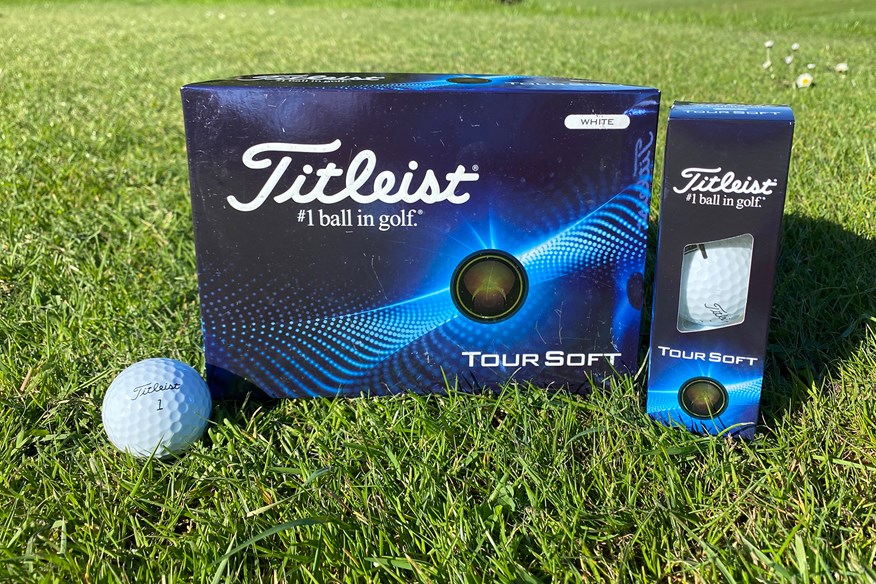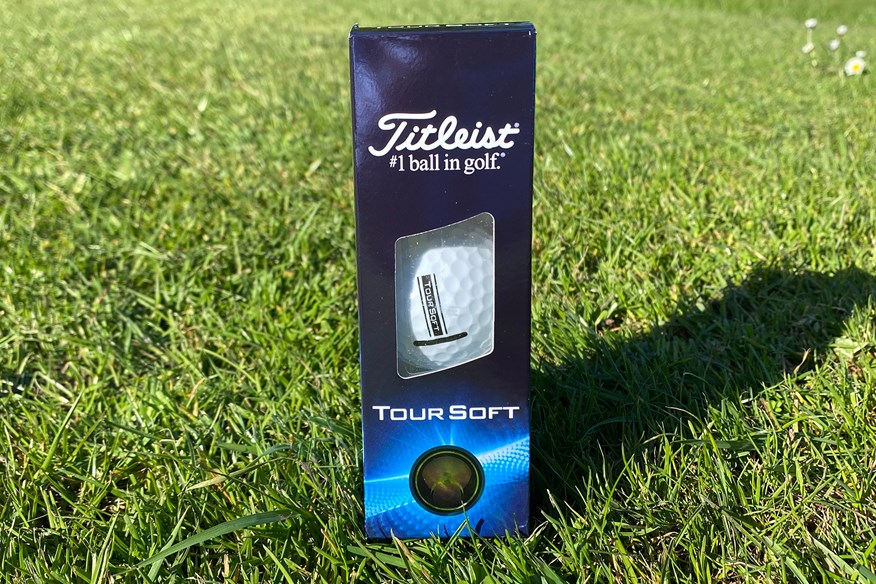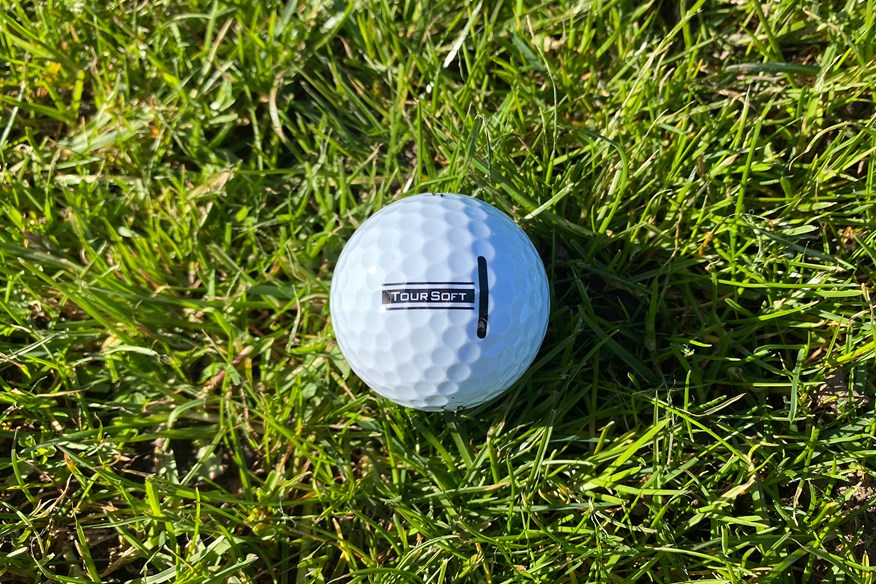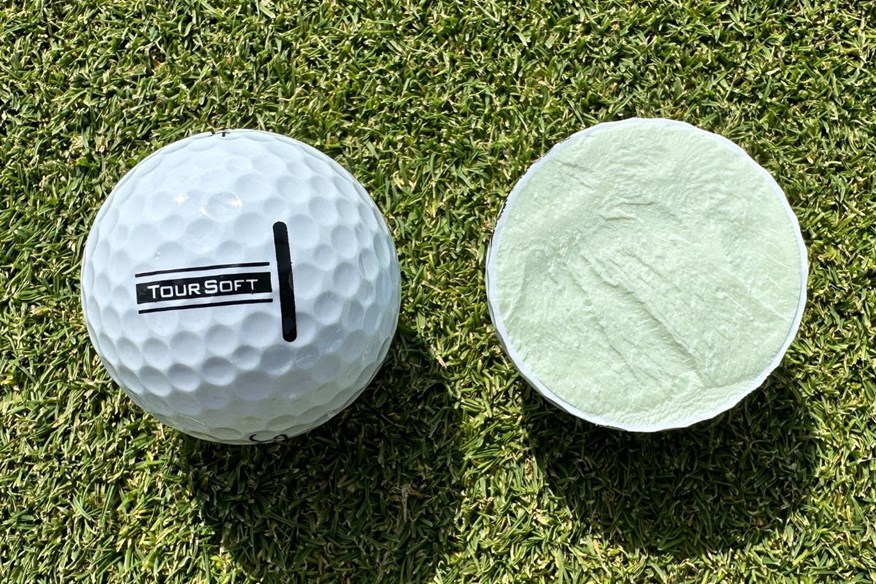This cheaper Titleist golf ball will make you think twice about playing Pro V1
Last updated:

The Titleist Pro V1 is the No.1 ball in golf, but this two-piece model from the same brand gives it a run for its money…
There’s no denying that Titleist makes some of the best golf balls in the game, but it’s not just their premium golf balls played on Tour that deserve your attention.
Our 2025 robot test results prove this, and there’s one particular two-piece golf ball that’s worthy of your consideration if you frequently use the Titleist Pro V1.
The Pro V1 is an excellent option for a wide range of golfers, as it is the most consistent golf ball. However, if you have the option to save some cash without sacrificing (or potentially gaining) performance, I’m sure you’ll be interested.
How we tested the golf balls
To find out, we tested 62 different golf balls on a $100,000 robot. This machine delivers exactly the same strike every time, which means the only variable in our test was the ball itself.
We tested every ball across five different shot types to get a complete picture of how the balls stacked up:
- 114mph driver – PGA Tour average
- 93mph driver – LPGA Tour and typical male club golfer
- 78mph driver – average female club golfer
- 7-iron – 80mph, which is club golfer average
- 56° wedge – hitting a 40-yard pitch shot
Titleist Pro V1 vs Titleist Tour Soft
There are a number of differences between the Titleist Pro V1 and Tour Soft, but not many similarities – especially when it comes to construction.
The graphic below details the differences between the two golf balls.
| Golf Ball | Titleist Pro V1 | Titleist Tour Soft |
| Construction | Three-piece | Two-piece |
| Cover material | Urethane | Fusablend (a proprietary combination of ionomers and softening polymers) |
| Dimple design | Spherically-tiled 388 tetrahedral | 346 quadrilateral dipyramid |
| Core | High-gradient | Large, fast core |
| Tour usage | Yes (No.1 ball in golf) | No |
Despite there being stark differences between the Pro V1 and Tour Soft, our 2025 robot test results highlighted a couple of similarities and some interesting findings you might not expect.
The results
We’ll break down the results into driver performance, irons, and wedges.
Driver – 78mph swing speed
| Golf Ball | Carry distance (yds) | Carry distance rank | Ball speed (mph) | Ball speed rank |
| Titleist Pro V1 | 161.0 | 16th | 113.1 | 14th |
| Titleist Tour Soft | 160.4 | 38th | 112.8 | 37th |
The ranking tells a very different story from the actual numbers, for golfers with slow swing speeds, neither golf ball is a bad option, although the Pro V1 is longer and faster, which you might not have expected given it’s played by some of the best golfers in the world.
Driver – 93mph swing speed
| Golf Ball | Carry distance (yds) | Carry distance rank | Ball speed (mph) | Ball speed rank |
| Titleist Pro V1 | 208.7 | 18th | 133.8 | 18th |
| Titleist Tour Soft | 208.5 | 23rd | 133.4 | 33rd |
It’s much closer between the Pro V1 and Tour Soft for golfers with average swing speeds, with only 0.2 carry yards between the two models. The Pro V1 continues to be faster, but it’s still minimal at 0.4mph.
Driver – 114mph swing speed
| Golf Ball | Carry distance (yds) | Carry distance rank | Ball speed (mph) | Ball speed rank |
| Titleist Pro V1 | 273.2 | 7th | 163.9 | 10th |
| Titleist Tour Soft | 271.3 | 18th | 163.3 | 23rd |
For golfers with fast swing speeds, the Pro V1 definitely presents itself as the superior model, given that it’s 1.9 yards longer and 0.6mph faster – the biggest gap at all three swing speeds. However, the Tour Soft isn’t disgraced, especially considering it’s a two-piece golf ball packed with a lot less technology than the Pro V1.
Conclusion
You’re probably not surprised to learn that the Pro V1 is quicker and longer than the Tour Soft, but it’s marginal despite the differences in construction. The Tour Soft performs extremely well and puts up a solid fight against the No.1 ball in golf, but sadly, it does lose out on all three swing speeds.
Distance and ball speed aren’t everything, and certain golfers will place more emphasis on spin and control, so does the Pro v1 continue to dominate the Tour Soft? Or does it all change?
| Golf ball | Carry distance (yds) | Carry distance rank | Backspin (rpm) | Backspin rank | Descent angle (°) | Descent angle rank |
| Titleist Pro V1 | 155.3 | 50th | 4,598 | 26th | 44.9 | 29th |
| Titleist Tour Soft | 154.2 | 57th | 4,774 | 14th | 45.2 | 8th |
Distance isn’t the focal point for the Pro V1 or Tour Soft when it comes to approach play, and that shows, because both of them are towards the bottom of the rankings for carry distance. The Tour Soft is shorter, but that becomes obvious when you look at its spin and descent angle.
Would have guessed that the two-piece Tour Soft is higher-spinning than the No.1 ball in golf? No? Neither would we!
It is, though – and by nearly 200rpm. Factor in its steeper descent angle, and the Tour Soft presents itself as the superior model to have at your disposal when firing at pins.
For a cheaper, two-piece golf ball, the Tour Soft is definitely holding its own against the Pro V1, even landing a heavy blow.
Surely that’s all going to change around the greens…
Wedges
| Golf ball | Backspin (rpm) | Backspin rank |
| Titleist Pro V1 | 5,692 | 33rd |
| Titleist Tour Soft | 6,075 | 6th |
I guarantee you weren’t expecting this!
The Tour Soft is over 400rpm higher-spinning than the Pro V1 at the 40-yard pitch shot. That’s pretty impressive, given the Tour Soft is made up of fewer layers and is a non-urethane model.
It’s not only impressive that the Tour Soft beats the Pro V1 for spin around the green, but also that it’s the sixth highest-spinning golf ball out of all 62 we tested. As well as being higher-spinning than the Pro V1, the Tour Soft is also higher-spinning than the Pro V1x (Titleist’s high-spin Tour-level premium golf ball).
The Tour Soft comfortably beats the Pro V1 for short-game performance, so what does that mean overall?
Which golf ball is the winner?
Gold medal for short game performance
Best Titleist high-spin golf ball






Moving to approach play, this golf ball is the bronze medal winner in this area. Tour Soft produces the second-highest spin (4,774rpm) and second-steepest descent angle (45.2°), but it is the shortest two-piece golf ball (154.2yds).
Off-the-tee performance has this golf ball very closely matched with Titleist's distance two-piece golf ball - Velocity. Granted, Tour Soft is slightly shorter and slower at all three swing speeds. However, giving up less than a yard off the tee at every swing speed is probably worth it for the approach play and short game performance gains. It performed well enough at 114mph to earn the silver medal for tee to green performance.
This is the highest-spinning two-piece golf ball on test. Across all three driver swing speeds, the 7-iron shot, and the 40-yard pitch, the Tour Soft generated 18,795rpm. Overall, the Tour Soft is the tenth-highest-spinning model on test, producing nearly 100rpm more than the Pro V1x and nearly 600rpm more than the Pro V1.
Tour Soft is a super consistent golf ball in every area. If you're looking for a two-piece golf ball that'll do everything, this golf ball needs to be on your mind.
On-course verdict
This is one of the best-feeling golf balls I've had the pleasure of playing with purely because of how soft it is. I'm not always a fan of soft golf balls, but when they feel as good as the Tour Soft does, there's nothing to dislike.
The feedback and response throughout the bag is exactly what you want with a soft golf ball, but it's most enjoyable when playing around the greens because you can really feel the ball interacting with the grooves.
Around the greens, this ball generates amazing spin and control that's capable of challenging the best high-spin golf balls.
Moving away from the green, I didn't notice anything special about the Tour Soft's performance, but in the same breath, there's nothing to criticize. If anything, this ball performs better than you would expect from a two-piece model.
The Titleist Tour Soft is great value, and if you want a soft-feeling golf ball, this is the model you want.
Pros
- Amazing short-game spin and control
- Incredibly soft and responsive
- Great value
Cons
- Short distance in iron play
| Carry distance (yds) | Driver 114mph - 271.3 | Driver 93mph - 208.5 | Driver 78mph - 160.4 | 7-iron - 154.2 |
| Ball speed (mph) | Driver 114mph - 163.3 | Driver 93mph - 133.4 | Driver 78mph - 112.8 | 7-iron - 108.3 |
| Backspin (rpm) | Driver 114mph - 2,776 | Driver 93mph - 2,731 | Driver 78mph - 2,438 | 7-iron - 4,774 | Pitch - 6,075 |
| Launch angle (°) | Driver 114mph - 11.1 | Driver 93mph - 13 | Driver 78mph - 14 | 7-iron - 21.1 | Pitch - 30.4 |
| Descent angle (°) | Driver 114mph - 37.6 | Driver 93mph - 32.8 | Driver 78mph - 27.3 | 7-iron - 45.2 | Pitch - 35.7 |
| Peak height (yds) | Driver 114mph - 32.6 | Driver 93mph - 22.8 | Driver 78mph - 15.4 | 7-iron - 29.5 | Pitch - 6.8 |
| Compression (psi) | 95 |
- Large, faster core
- Reformulated thin fusablend cover
- Proprietary quadrilateral dipyramid dimple design
- 346 dimples
- 2-Piece construction
- Available in white, green, and yellow
- An alternative model is AIM 360
Based on our robot test findings, both golf balls have their benefits.
The Pro V1 is a better option if you want more distance off the tee and lower spin. However, not every golfer wants that, and most golfers want more spin when playing into and around greens. In which case, the Tour Soft is the winner. It’s worth noting that the Tour Soft is the best high-spin Titleist golf ball.
At all three driver swing speeds, the most distance you’re going to give up by switching to the Tour Soft is 1.9 yards, but with an iron and wedge in hand, you’ll get more spin and control. The performance benefits from the fairway and around the greens will far outweigh the Pro V1’s superior performance off the tee for the majority of golfers.
The Tour Soft is also cheaper, so what have you got to lose in giving it a go?
